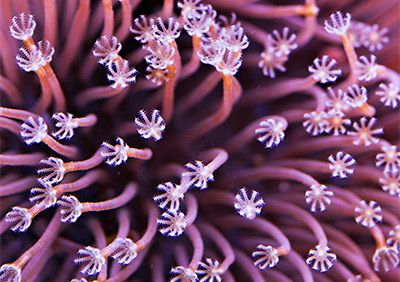The marine aquarium hobby is second only to the US military when it comes to the number of acronyms its members throw around. (Quite fittingly, this past Monday was the 27th anniversary of my DOE. Shortly after that date, I entered BMT as an A1C and did lots of PC under the direction of a TI before going on to AIT where I got an LOR for violating the UCMJ in advance of my PCS.) For today’s post, I’d like to address a somewhat common hobby acronym mentioned in an email I received from one of our readers. He quite succinctly queried, “What the heck does ‘PE’ stand for? I see it used in online forums a lot.”
The acronym “PE” has the distinction of representing two terms in our hobby. If you read it in the context of a discussion on foods and feeding, the acronym likely refers to Piscine Energetics, a company headquartered in British Columbia that supplies PE Mysis®, a popular brand of Mysis relicta, among other products.
But in hobby parlance, “PE” can also stand for “polyp extension,” which is exactly what it sounds like—the degree to which a coral extends its polyps. Why does this matter? Good polyp extension is regarded as a sign that a coral specimen is in good health and generally “happy” with its placement and environmental conditions. Of course, hobbyists also like to see full polyp extension in their corals because that’s the state in which they tend to be most appealing from an aesthetic standpoint.
On the other hand, poor or nonexistent polyp extension is often the first sign that something isn’t quite right with a coral. The challenge becomes determining exactly what’s causing the issue because virtually any problem affecting corals—from nipping fish to parasitic pests, inappropriate lighting or flow, poor overall water quality, an out-of-whack water parameter, and a host of other factors—can cause the symptom of polyp retraction. A lot of detective work is usually needed to get to the bottom of things.
Also, it’s important to keep in mind that occasional lack of polyp extension is not necessarily cause for alarm. In fact, for some corals it’s par for the course. For example, as a normal regenerative process, many of the so-called leather corals (e.g., Sarcophyton, Lobophytum, and Sinularia spp.) will routinely retract their polyps, develop a waxy coating over their tissues, and then shed the coating, reemerging healthier than ever.
That being said, poor polyp extension can be a warning sign even for leather corals, for instance if they’re constantly going into and out of this phase or they remain in a contracted state for an unusually long period. The contracted regenerative state should be the exception with these corals, not the rule. So, even with rugged leather corals, you have to be attuned to the natural ebb and flow of polyp extension.



